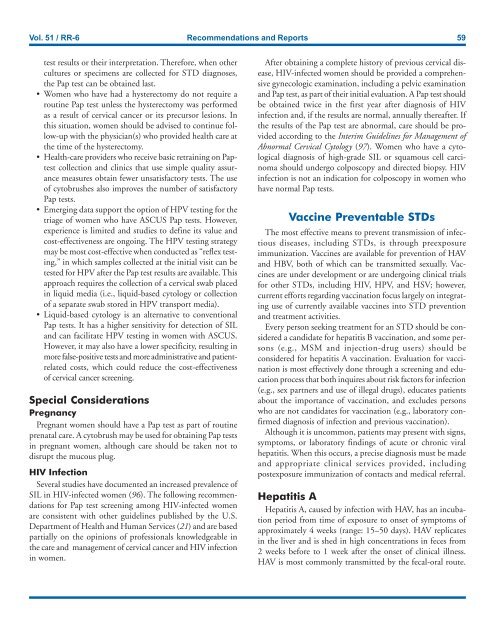You also want an ePaper? Increase the reach of your titles
YUMPU automatically turns print PDFs into web optimized ePapers that Google loves.
Vol. 51 / RR-6 Recommendations and Reports 59<br />
test results or their interpretation. Therefore, when other<br />
cultures or specimens are collected for STD diagnoses,<br />
the Pap test can be obtained last.<br />
Women who have had a hysterectomy do not require a<br />
routine Pap test u<strong>nl</strong>ess the hysterectomy was performed<br />
as a result of cervical cancer or its precursor lesions. In<br />
this situation, women should be advised to continue follow-up<br />
with the physician(s) who provided health care at<br />
the time of the hysterectomy.<br />
Health-care providers who receive basic retraining on Paptest<br />
collection and clinics that use simple quality assurance<br />
measures obtain fewer unsatisfactory tests. The use<br />
of cytobrushes also improves the number of satisfactory<br />
Pap tests.<br />
Emerging data support the option of HPV testing for the<br />
triage of women who have ASCUS Pap tests. However,<br />
experience is limited and studies to define its value and<br />
cost-effectiveness are ongoing. The HPV testing strategy<br />
may be most cost-effective when conducted as “reflex testing,”<br />
in which samples collected at the initial visit can be<br />
tested for HPV after the Pap test results are available. This<br />
approach requires the collection of a cervical swab placed<br />
in liquid media (i.e., liquid-based cytology or collection<br />
of a separate swab stored in HPV transport media).<br />
Liquid-based cytology is an alternative to conventional<br />
Pap tests. It has a higher sensitivity for detection of SIL<br />
and can facilitate HPV testing in women with ASCUS.<br />
However, it may also have a lower specificity, resulting in<br />
more false-positive tests and more administrative and patientrelated<br />
costs, which could reduce the cost-effectiveness<br />
of cervical cancer screening.<br />
Special Considerations<br />
Pregnancy<br />
Pregnant women should have a Pap test as part of routine<br />
prenatal care. A cytobrush may be used for obtaining Pap tests<br />
in pregnant women, although care should be taken not to<br />
disrupt the mucous plug.<br />
HIV Infection<br />
Several studies have documented an increased prevalence of<br />
SIL in HIV-infected women (96). The following recommendations<br />
for Pap test screening among HIV-infected women<br />
are consistent with other guidelines published by the U.S.<br />
Department of Health and Human Services (21) and are based<br />
partially on the opinions of professionals knowledgeable in<br />
the care and management of cervical cancer and HIV infection<br />
in women.<br />
After obtaining a complete history of previous cervical disease,<br />
HIV-infected women should be provided a comprehensive<br />
gynecologic examination, including a pelvic examination<br />
and Pap test, as part of their initial evaluation. A Pap test should<br />
be obtained twice in the first year after diagnosis of HIV<br />
infection and, if the results are normal, annually thereafter. If<br />
the results of the Pap test are abnormal, care should be provided<br />
according to the Interim Guidelines for Management of<br />
Abnormal Cervical Cytology (97). Women who have a cytological<br />
diagnosis of high-grade SIL or squamous cell carcinoma<br />
should undergo colposcopy and directed biopsy. HIV<br />
infection is not an indication for colposcopy in women who<br />
have normal Pap tests.<br />
Vaccine Preventable STDs<br />
The most effective means to prevent transmission of infectious<br />
diseases, including STDs, is through preexposure<br />
immunization. Vaccines are available for prevention of HAV<br />
and HBV, both of which can be transmitted sexually. Vaccines<br />
are under development or are undergoing clinical trials<br />
for other STDs, including HIV, HPV, and HSV; however,<br />
current efforts regarding vaccination focus largely on integrating<br />
use of currently available vaccines into STD prevention<br />
and treatment activities.<br />
Every person seeking treatment for an STD should be considered<br />
a candidate for hepatitis B vaccination, and some persons<br />
(e.g., MSM and injection-drug users) should be<br />
considered for hepatitis A vaccination. Evaluation for vaccination<br />
is most effectively done through a screening and education<br />
process that both inquires about risk factors for infection<br />
(e.g., sex partners and use of illegal drugs), educates patients<br />
about the importance of vaccination, and excludes persons<br />
who are not candidates for vaccination (e.g., laboratory confirmed<br />
diagnosis of infection and previous vaccination).<br />
Although it is uncommon, patients may present with signs,<br />
symptoms, or laboratory findings of acute or chronic viral<br />
hepatitis. When this occurs, a precise diagnosis must be made<br />
and appropriate clinical services provided, including<br />
postexposure immunization of contacts and medical referral.<br />
Hepatitis A<br />
Hepatitis A, caused by infection with HAV, has an incubation<br />
period from time of exposure to onset of symptoms of<br />
approximately 4 weeks (range: 15–50 days). HAV replicates<br />
in the liver and is shed in high concentrations in feces from<br />
2 weeks before to 1 week after the onset of clinical illness.<br />
HAV is most commo<strong>nl</strong>y transmitted by the fecal-oral route.


